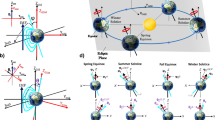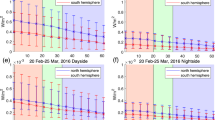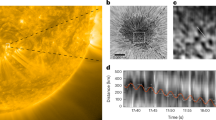Abstract
A THEORETICAL investigation has been made of the outlying regions of the atmosphere of the earth and of the effect of sunlight on these regions; certain of the conclusions are given in this preliminary note. By the usual methods the temperatures and the pressures of the atmosphere to great heights were calculated for a quiet sun, that is, the sun in its normal state, with no terrestrial auroræ or magnetic storms. Because of the unequal balance at cold temperatures between the solar energy absorbed in the ultra-violet by the atmospheric gases and the energy re-emitted in the infra-red by the gases, the daytime temperatures above 100 km. were found to increase with the height above the surface of the earth, until at 300 km. or 400 km. temperatures of 1000° Kelvin seem reasonable. (There is, of course, nothing novel in this, although we have been interested in working the matter out more exactly perhaps than has been done heretofore.)
This is a preview of subscription content, access via your institution
Access options
Subscribe to this journal
Receive 51 print issues and online access
$199.00 per year
only $3.90 per issue
Buy this article
- Purchase on SpringerLink
- Instant access to full article PDF
Prices may be subject to local taxes which are calculated during checkout
Similar content being viewed by others
Author information
Authors and Affiliations
Rights and permissions
About this article
Cite this article
MARIS, H., HULBURT, E. The Ultra-Violet Light of the Sun as the Origin of Auroræ and Magnetic Storms. Nature 122, 807–808 (1928). https://doi.org/10.1038/122807a0
Issue date:
DOI: https://doi.org/10.1038/122807a0



